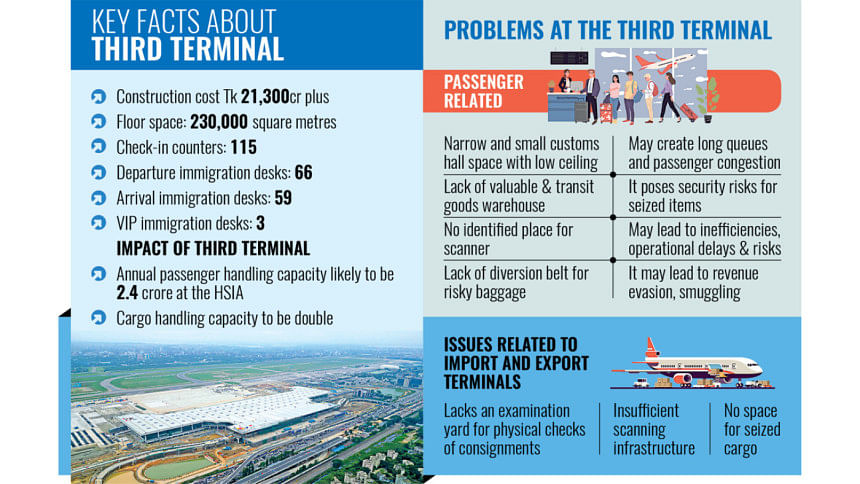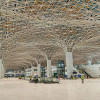Customs flags hurdles at 3rd terminal of Dhaka airport

The customs authorities have identified a number of operational bottlenecks at the much-anticipated third terminal of Hazrat Shahjalal International Airport (HSIA), widely known as Dhaka airport.
In a letter sent to the Civil Aviation Authority of Bangladesh (CAAB), the Customs House Dhaka said it has found more than a dozen issues related to infrastructure, security, and operational readiness of the new terminal, which is expected to open in early 2026.
The assessment comes as authorities move to efficiently manage the rise in passenger traffic and cargo volumes at the country's largest airport.
In March this year, the customs authorities, operating under the National Board of Revenue (NBR), conducted inspections of the third terminal, as well as the new Import Cargo Terminal (ICT) and Export Cargo Terminal (ECT).
The NBR's field office, in its letter sent to CAAB in the third week of March, said it had held several meetings with various agencies, including CAAB, to ensure smooth operation at the third terminal.
Built at a cost of more than Tk 21,300 crore, the majority of which was funded by loans from the Japan International Cooperation Agency (JICA), the iconic terminal is seen as a milestone for Bangladesh's aviation sector.
However, customs officials, after the inspection, say unresolved issues could undermine its efficiency.

"The third terminal is a significant development in Bangladesh's aviation sector, but certain key challenges must be addressed to ensure smooth customs operations," said the Customs House Dhaka.
One of the major challenges is the size and design of the customs hall, which officials say is too narrow, with a low ceiling and limited capacity.
The space may be required to handle as many as 7,000 to 8,000 passengers at a time, but it can accommodate only around 300 people.
"There are 16 belts at the new terminal compared to only 8 now at Dhaka airport. Just imagine how long the queue of passengers will be for customs checks at the new terminal," said a senior customs official.
Officials fear the cramped conditions will lead to long queues even before passengers reach the hall.
The low ceiling could also cause poor ventilation and congestion, slowing down clearance processes.
"It may require a longer time for passenger clearance and, as a result, may have a negative impact on the overall performance indicator of the airport," the customs letter mentioned, recommending an expansion of the customs area.
Spanning 230,000 square metres, the third terminal features 115 check-in counters, 66 departure immigration desks, 59 arrival desks, and three VIP counters.
Upon full operation of the new terminal, the annual passenger handling capacity of Dhaka airport will rise to 2.4 crore, including throughput from the existing terminals.
At present, the airport manages around 80 lakh passengers and 500,000 tonnes of cargo per year.
With the new terminal in operation, cargo handling capacity at the airport is also expected to double, but customs authorities have pointed out a number of issues.
For instance, there is no designated warehouse for high-value or transit goods, posing a security risk for seized items.
"It poses a security risk for seized items," customs officials wrote, seeking a secure storage space with restricted access to prevent theft or misuse of seized goods.
"This could lead to inefficiencies, operational delays, and increased risks in customs handling. If not addressed, it may result in revenue loss, smuggling opportunities, and challenges in passenger baggage management," the report said.
Concerns have also been raised about the placement of the duty-free shop, which sits directly after immigration.
Customs said this layout could facilitate the concealment of dutiable goods and recommended stricter staff access control and enhanced surveillance in the area.
In addition, there is no space allocated for scanners, nor seating for scanner operators, the report said, adding that this shortcoming could again lead to smuggling risks and revenue leakage.
Other issues include the absence of a diversion route for high-risk baggage and the location of the baggage storage room within the airside area, which customs says could hamper efficiency.
Customs officials have called for a dedicated baggage inspection zone accessible to passengers. There is also no organised system to transport suspicious baggage for further checks or storage.
At the import cargo terminal, customs found no designated examination yard or space for physically inspecting consignments.
"While scanning is helpful for trade facilitation, there is a need for physical examination along with scanning for the proper collection of taxes and duties. However, the warehouse design does not have any yard or space for physical examination of imported consignments," the report said.
"There is a great possibility of tax evasion and an increase in smuggling tendencies," it said.
Customs has also requested at least one dedicated warehouse for storing seized goods over longer periods.
The NBR's customs wing also said there are four scanning rooms to examine imported goods, but space for installing the necessary equipment is insufficient.
Regarding the ECT, customs has recommended installing at least two baggage scanners and one vehicle scanner, along with space for physical checks.
Contacted, Md Zakir Hossain, commissioner of Customs House Dhaka, said they are trying to address some issues alternatively.
"However, there are some obstacles which need to be addressed. If not, it will create problems for us to provide a service. But the good part is that we and the civil aviation authority are working together to minimise the problems before the terminal opens," he said.
Air Vice Marshal Md Monjur Kabir Bhuiyan, chairman of CAAB, said they had held multiple meetings with customs officials and had already addressed most of the issues.
"It's true that there are some shortcomings in infrastructure for which we have provided solutions in other ways, because we won't be able to alter the existing infrastructure by breaking it," he said.
Still, he hoped that customs operations would face no disruption in carrying out operations at the new terminal.


 For all latest news, follow The Daily Star's Google News channel.
For all latest news, follow The Daily Star's Google News channel. 






Comments